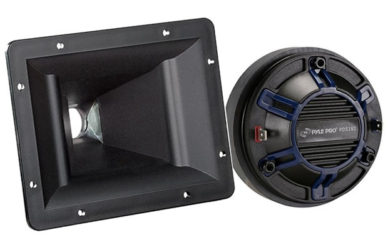| Pyle PDS182 compression driver
Fig 1 shows the different responses of the PDS182 with the PH565 horn. BLACK trace = RAW (no crossover, no CDEQ) As luck would have it, the Red trace looked promising. |
 (Fig 1) Frequency Response of Pyle PDS182 /PH565 |
| Pyle PDS182/PH565 with Dayton RS180S
Fig 2 shows the crossover slopes of a Dayton RS180S and the Pyle PDS182/PH565 with the electronic crossover at 2kHz (24dB/oct). Note that acoustically, the drivers are crossing at about 1.8kHz. This is due to the fact that the natural responses of the two drivers are not perfectly flat. |
 (Fig 2) Dayton RS180S + Pyle PDS182/PH565 |
| Summed Response (No Time Alignment)
The Red trace in Fig 3 is the summed response of the drivers in Fig 2. Without any time alignment, cancellation can be seen on the right of the crossover frequency. |
 (Fig 3) Summed Response |
| Summed Response with PDS182 Reverse Phase
The Red trace in Fig 4 is the summed response with the PDS182 in Reverse Phase. Now, a distinct notch appears on the left of the crossover frequency. Clearly, the large offset of the acoustic centers of the midwoofer and compression driver is playing havoc with the crossover. |
 (Fig 4) Summed Response with PDS182 in Reverse Phase |
| Adding Delay for Time Alignment
To solve the offset issue, a time delay is added to the Dayton RS180S. With the PDS182 still wired in reverse phase, the delay is adjusted until a deep notch is seen (Red trace in Fig 5). This is an indication that the acoustic centers are aligned. |
 (Fig 5) Time Aligned Summed Response with PDS182 in Reverse Phase |
| Time Aligned RS180S/PDS182
With the correct delay amount established, the PDS182 is rewired back to normal phase. The Red trace in Fig 6 shows perfect summing now. No cancellations are observed on either side of the crossover frequency. |
 (Fig 6) Time Aligned Summed Response |
| Time Aligned Frequency Response
For clarity, the RS180S and the PDS182 slopes are removed, leaving the summed response (Red trace in Fig 7). |
 (Fig 7) Time Aligned Summed Response |
| Sound Quality
Frankly, the Pyle PDS182 sounds exceptionally good compared to the rest. This goes to show that when it comes to horns, how well a compression driver matches the horn is key to the ultimate sound quality. Putting it another way, you can have an expensive compression driver but if it doesn’t match the horn, it’s not going to work. Brands like Pyle are associated with low quality due to their prices. Granted that some budget drivers are terrible, I would say Pyle is an exception. They are excellent value for money. This PDS182 compression driver is proof. It cost only $18. Add $6 for the horn and for a grand total of $24, it beats a lot of dome tweeters costing twice as much. |
|
